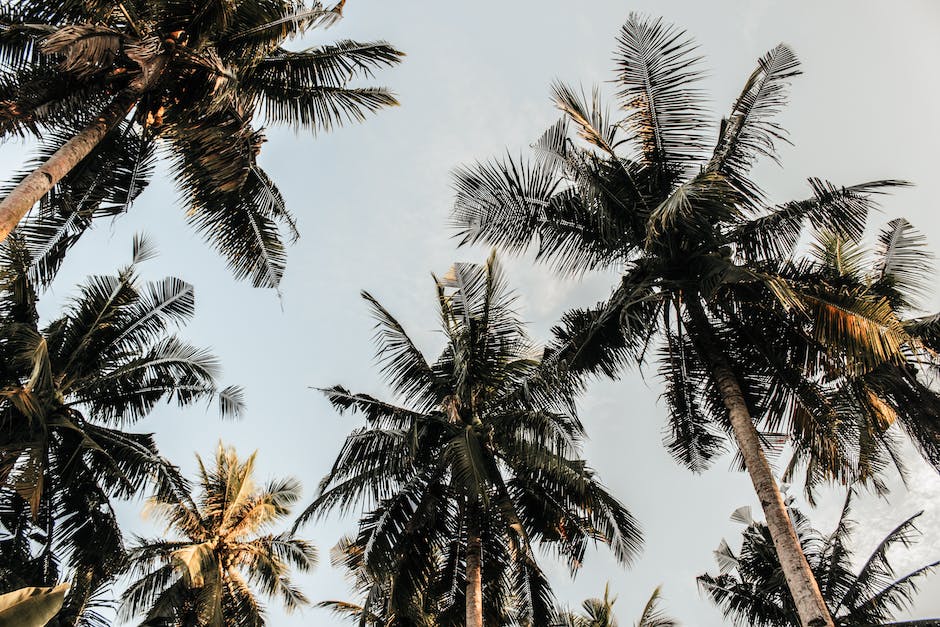Figuring out if your palm tree is dying can seem like a daunting task, but there are some tell-tale signs that will help you determine if your palm is on its last legs. First, take a look at the leaves. Are they brown and wilted, or are they green and healthy? If they’re brown and wilted, that’s a sign that your palm tree is not getting enough water. Another sign of a dying palm tree is a yellowing or browning of the trunk. If the trunk of your palm tree is starting to turn brown, that’s a sure sign that the tree is dying. Finally, check the roots. Are the roots healthy and green, or are they brown and dry? If the roots are brown and dry, that’s a sign that the tree is not getting enough nutrients and is dying.
The first thing you’ll notice is that the leaves of your palm tree will start to turn brown and fall off. Additionally, the trunk may start to turn brown and/or crack. If your palm tree is losing its leaves and/or trunk is discoloring, it is likely dying.
How do you revive a dying palm tree?
If you want to revive a palm tree, you should follow these steps:
1. Add the proper amount of water.
2. Use high-quality fertilizer.
3. Use top-notch soil.
4. Cut fronds only after they are dead.
5. Do not prune during hurricane season.
6. Plant palms at the right level.
7. Provide the right nutrients.
8. Increase or decrease sunlight.
If you see any of the above mentioned signs, it is possible that your palm tree is dying or already dead. In some cases, the damage can be stopped and reversed, so don’t panic. Try to assess the situation and see if there is anything you can do to save the palm tree.
Will dead palm trees grow back
No, a dead palm tree cannot come back to life. If a palm tree is neglected and dies, it does not come back to life. The key to a palm tree’s continual survival is the top ‘bud’ of the tree where the leaves gown from. Once this dries, the rest of that palm tree goes with it.
If you see any of these signs in your palm tree, it’s likely that it’s being overwatered. Overwatering is a common problem with palm trees, and can lead to serious health problems for the tree. If you think your palm tree may be overwatered, take action to correct the problem immediately.
What does a sick palm tree look like?
If you notice that the top center stalks of your palm tree are turning brown and/or shriveling, this is a sign that your tree is not doing well. Palm trees are susceptible to a variety of diseases, so it’s important to keep an eye on the health of your tree and take action if you notice any signs of illness.
If the leaves of your palm tree are brown or yellow and wilting significantly, this means they’re dead and you should remove them. Broken fronds should also be removed, as they can damage your tree. Finally, you’ll want to remove fruit stalks of palm flowers since these use up a lot of your palm tree’s energy.
What is the average lifespan of a palm tree?
Palm trees have relatively short lifespans. The areca palm has a fairly short lifespan of 40 to 50 years, while the popular coconut palm lives between 70 and 100 years, and most date palms hang on for 100 to 120 years. The date palm can reach 200 years of age in some cases, however.
Root rot is a serious problem for plants and can cause them to die if not treated. The signs of root rot are slow growth, mushy stems, and wilting, yellow, distorted leaves. Usually the soil will smell rotten and the roots will appear to be reddish brown. If you think your plant has root rot, you should take it to a garden center or nursery to get it diagnosed and treated.
How do I know if my palm tree needs water
If you are unsure about whether your palm needs water, stick your finger in the soil next to the plant. If the soil is dry at least a couple of inches below the surface, then water the plant. If the soil is moist, then the plant does not need water.
If your tree is experiencing browning leaves, it could be for a variety of reasons. Make sure that your tree is getting enough water, and that it is not deficient in key nutrients like nitrogen, manganese or magnesium. Some pests can also cause browning leaves, such as palm tree weevils or spider mites. If your tree is suffering from a disease like Ganoderma butt rot, this could also be the cause.
Can brown palm leaves turn green again?
If you have a brown palm leaf, it is best to remove the damaged area and adjust your care routine or plant environment so new, healthy leaves can grow. Once a leaf has turned brown, it cannot turn green again.
Palms are unique in that they replace their leaves throughout the growing season. As a palm tree leaf reaches the end of its natural life, it turns brown–beginning at the tip and continuing until the leaf completely browns and drops off. This process is called abscission, and it allows palms to continually produce new leaves, which is essential for photosynthesis and the tree’s overall health.
How do you tell if Underwatering vs overwatering
If you see browning leaves on your plant, feel the leaf to see if it is crispy and light. If it is, this is an indication of under watering. If the leaf feels soft and limp, this is an indication of overwatering. Yellowing leaves are usually accompanied by new growth falling. This is also an indication of overwatering.
Water is essential for plants, but too much or too little can be detrimental. Underwatering plants can cause dry leaves, brown tips, leaf drop, wilting, and leaf curling. The soil will feel dry, but the plant will improve after watering. Overwatering, on the other hand, can cause yellowing leaves, brown tips, wilting despite wet soil, and also symptoms of underwatering if root rot has started. Be mindful of how much water your plants are getting to keep them healthy and happy.
Which is worse overwatering or underwatering?
Here are some signs that your lawn may be overwatered:
1. The grass is extremely green and looks healthy, but after a few days it begins to turn brown and wilt.
2. There is a lot of standing water on the surface of the lawn after you water.
3. The lawn feels spongy when you walk on it.
4. The grass has a “mushy” appearance.
5. There is a lot of runoff from your watering can when you water the lawn.
If you see any of these signs, it’s important to cut back on watering immediately. overwatering is not only harmful to your lawn, but can also lead to serious soil problems.
Palm trees are interesting in that they lack cambium, which is a layer of tissue behind the tree bark that creates growth rings. This means that any wounds inflicted on the trunk cannot heal, and will remain on the palm tree for its lifetime. This can be a disadvantage, but also makes palm trees unique and interesting.
Do palm trees heal themselves
Cambium is a layer of tissue behind the tree bark that creates growth rings in the tree. Palm trees lack cambium, meaning they can’t repair themselves if they’re wounded. Any wound inflicted on a palm tree trunk will remain with the tree for the rest of its life.
Before you start to panic, it is important to figure out what is causing your palm tree to be sick. Once you have determined the cause, you can start to take steps to fix the issue. If you are unsure what is causing the problem, it is best to consult with a palm tree expert.
Warp Up
The surest way to tell if your palm tree is dying is by examining the leaves. If they are brown and brittle, or if there are no leaves at all, then the tree is likely dying. Other signs include a trunk that is soft or discolored, and a lack of new growth. If you see any of these signs, it’s important to take action to save the tree.
If your palm tree is yellowing and Drooping, it is likely dying. If the fronds are brown and brittle, it is also likely dying. If the trunk is soft or discolored, it is also likely dying. If your palm tree is authenticity show these signs, it is probably dying and you should consult a tree expert to confirm.
Mark Hoffman is a dedicated arborist and tree care specialist with over a decade of experience. His love for trees began when he visited Yosemite National Park as a teenager and was awestruck by the giant sequoias. Mark pursued his passion by studying forestry at Michigan Technological University, where he earned a Bachelor of Science degree.
Since then, he has worked tirelessly in the field of arboriculture, helping to preserve and protect trees in his community. His expertise and dedication have made him a respected leader in the industry and a valuable resource for anyone seeking advice on tree care.
